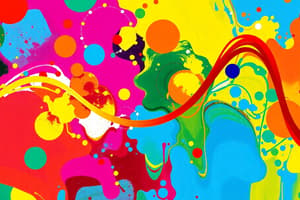Podcast
Questions and Answers
Which theory explains how chemical reactions occur and why reaction rates vary?
Which theory explains how chemical reactions occur and why reaction rates vary?
- Atomic theory
- Thermodynamics
- Collision theory (correct)
- Quantum theory
What is the term used to describe the interaction between atoms involving the valence electrons of one atom and the nucleus of another?
What is the term used to describe the interaction between atoms involving the valence electrons of one atom and the nucleus of another?
- Atomic interaction
- Chemical bonding (correct)
- Molecular bonding
- Chemical reaction
What happens during a chemical reaction?
What happens during a chemical reaction?
- The bonds between the particles of the reagents are formed
- The bonds between the particles of the reagents are broken and new bonds are formed (correct)
- The bonds between the particles of the products are formed
- The bonds between the particles of the products are broken and new bonds are formed
What is activation energy?
What is activation energy?
What happens if the activation energy is low?
What happens if the activation energy is low?
What are the sources of energy required for a reaction to occur?
What are the sources of energy required for a reaction to occur?
Under what conditions will there be no reaction?
Under what conditions will there be no reaction?
What is the reason for a reaction not occurring even if the particles collide?
What is the reason for a reaction not occurring even if the particles collide?
Can a reaction occur if the reagents have less stored energy than the products?
Can a reaction occur if the reagents have less stored energy than the products?
Study Notes
Chemical Reaction Theories
- The collision theory explains how chemical reactions occur focusing on particle collisions and energy transfer.
- Factors affecting reaction rates include concentration, temperature, surface area, and the presence of catalysts.
Atomic Interaction
- Chemical bonding involves the interaction between atoms, particularly the valence electrons of one atom and the nucleus of another.
Chemical Reaction Process
- During a chemical reaction, bonds between atoms break and new bonds form, resulting in the formation of different substances (products).
Activation Energy
- Activation energy is the minimum energy required to initiate a chemical reaction and overcome the energy barrier for bond breaking.
Low Activation Energy Effects
- If the activation energy is low, reactions can occur at lower temperatures, increasing reaction rates and dynamics.
Energy Sources for Reactions
- Reactants require energy from various sources such as heat, light, or electricity to initiate chemical reactions and facilitate bond breaking.
Conditions for No Reaction
- No reaction will occur under conditions where reactants are at very low energy states or lack sufficient activation energy to overcome barriers.
Collision Requirements
- Even with particle collisions, if the reactants do not have the correct orientation or enough energy, a reaction may not occur.
Energy Levels of Reactants and Products
- A reaction cannot proceed spontaneously if the reactants have less stored energy compared to the products; sufficient activation energy is needed to convert them.
Studying That Suits You
Use AI to generate personalized quizzes and flashcards to suit your learning preferences.
Description
Test your knowledge on Chemical Bonding and Collision Theory with this quiz! From valence electrons to new substances, this quiz will challenge your understanding of chemical reactions and the fundamental principles behind them. Sharpen your chemistry skills and discover how Max Trautz and William Lewis' collision theory plays a crucial role in explaining chemical reactions. Take the quiz now and become a chemistry expert!




